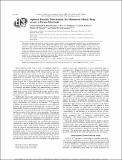| dc.contributor.author | Braatz, Richard D. | |
| dc.contributor.author | Ramadesigan, Venkatasailanathan | |
| dc.contributor.author | Methekar, Ravi N. | |
| dc.contributor.author | Latinwo, Folarin | |
| dc.contributor.author | Subramaniana, Venkat R. | |
| dc.date.accessioned | 2013-03-21T17:26:03Z | |
| dc.date.available | 2013-03-21T17:26:03Z | |
| dc.date.issued | 2010-10 | |
| dc.date.submitted | 2010-09 | |
| dc.identifier.issn | 0013-4651 | |
| dc.identifier.uri | http://hdl.handle.net/1721.1/77969 | |
| dc.description.abstract | This paper considers the design of spatially varying porosity profiles in next-generation electrodes based on simultaneous optimization of a porous-electrode model. Model-based optimal design (not including the solid-phase intercalation mechanism) is applied to a porous positive electrode made of lithium cobalt oxide, which is commonly used in lithium-ion batteries for various applications. For a fixed amount of active material, optimal grading of the porosity across the electrode was found to decrease the ohmic resistance by 15%–33%, which in turn increases the electrode capacity to hold and deliver energy. The optimal porosity grading was predicted to have 40% lower variation in the ohmic resistance to variations in model parameters due to manufacturing imprecision or capacity fade. The results suggest that the potential for the simultaneous model-based design of electrode material properties that employ more detailed physics-based first-principles electrochemical engineering models to determine optimal design values for manufacture and experimental evaluation. | en_US |
| dc.description.sponsorship | National Science Foundation (U.S.) (Contract CBET-0828002) | en_US |
| dc.description.sponsorship | National Science Foundation (U.S.) (Contract CBET-0828123) | en_US |
| dc.description.sponsorship | National Science Foundation (U.S.) (Contract CBET-1008692) | en_US |
| dc.language.iso | en_US | |
| dc.publisher | The Electrochemical Society | en_US |
| dc.relation.isversionof | http://dx.doi.org/10.1149/1.3495992 | en_US |
| dc.rights | Article is made available in accordance with the publisher's policy and may be subject to US copyright law. Please refer to the publisher's site for terms of use. | en_US |
| dc.source | MIT Web Domain | en_US |
| dc.title | Optimal Porosity Distribution for Minimized Ohmic Drop across a Porous Electrode | en_US |
| dc.type | Article | en_US |
| dc.identifier.citation | Ramadesigan, Venkatasailanathan et al. “Optimal Porosity Distribution for Minimized Ohmic Drop Across a Porous Electrode.” Journal of The Electrochemical Society 157.12 (2010): A1328. ©2010 ECS - The Electrochemical Society | en_US |
| dc.contributor.department | Massachusetts Institute of Technology. Department of Chemical Engineering | en_US |
| dc.contributor.mitauthor | Braatz, Richard D. | |
| dc.relation.journal | Journal of The Electrochemical Society | en_US |
| dc.eprint.version | Final published version | en_US |
| dc.type.uri | http://purl.org/eprint/type/JournalArticle | en_US |
| eprint.status | http://purl.org/eprint/status/PeerReviewed | en_US |
| dspace.orderedauthors | Ramadesigan, Venkatasailanathan; Methekar, Ravi N.; Latinwo, Folarin; Braatz, Richard D.; Subramanian, Venkat R. | en |
| dc.identifier.orcid | https://orcid.org/0000-0003-4304-3484 | |
| mit.license | PUBLISHER_POLICY | en_US |
| mit.metadata.status | Complete | |
